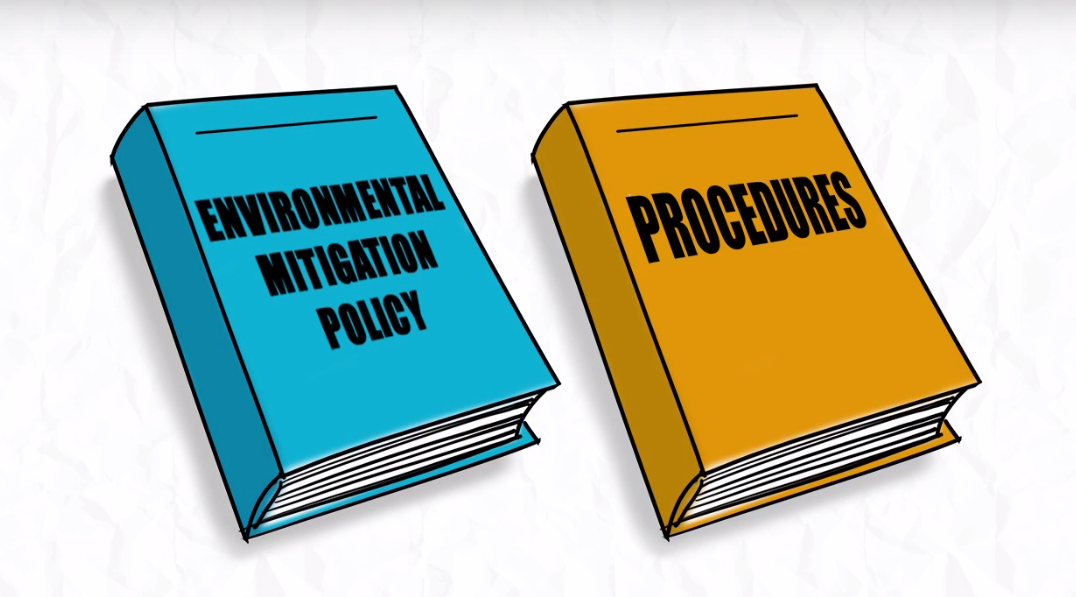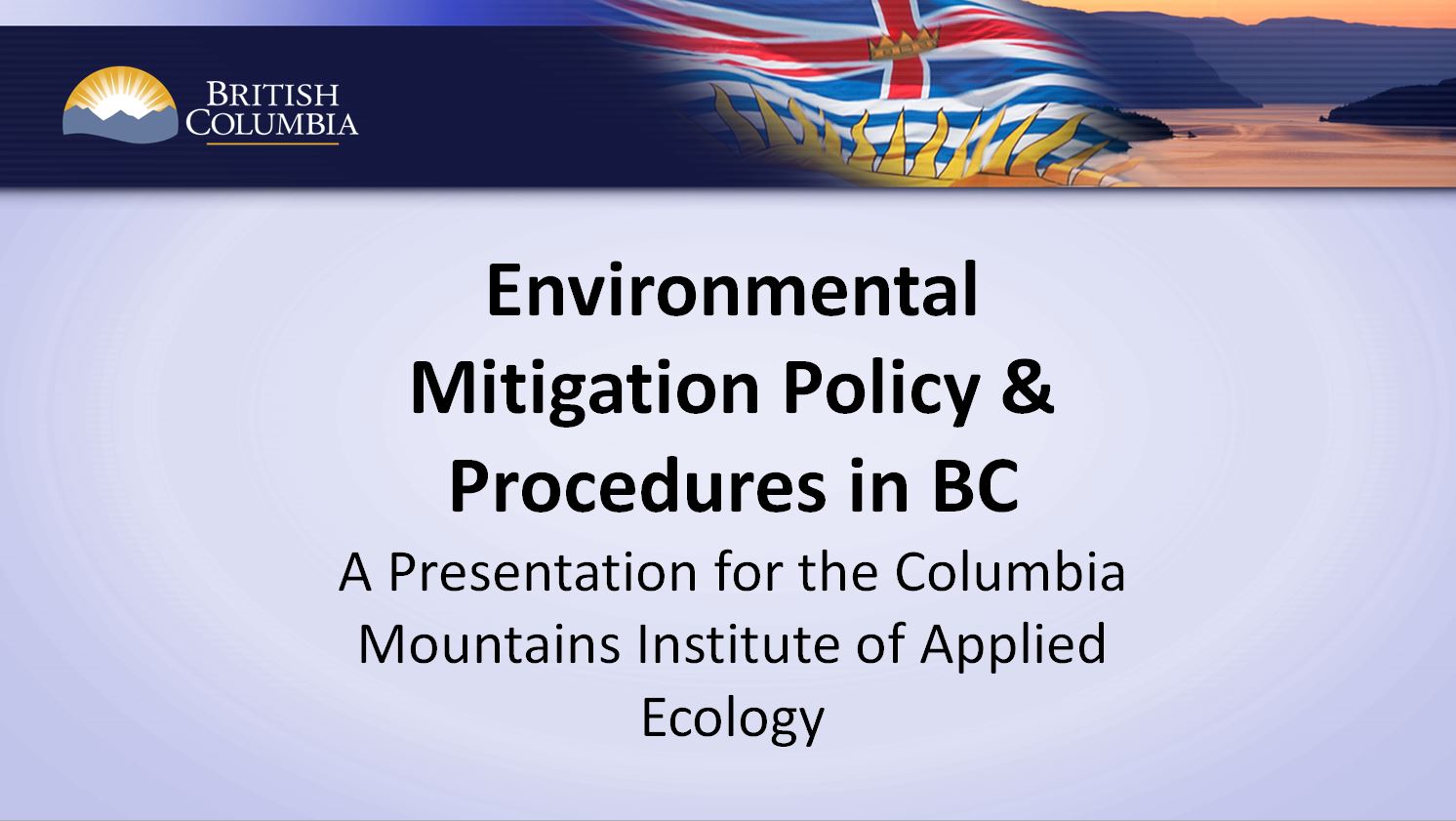Environmental Mitigation Policy for B.C.
The Environmental Mitigation Policy and supporting procedures outline a process for making well-informed, sound decisions about how to use or develop B.C.’s natural resources by:
- Offering guidance that allows for flexibility – instead of using a “one-size-fits-all” approach
- Fostering understanding and consideration of environmental values
- Mitigating negative impacts to the environment and communities
Interim Mitigation Offset Guidance for Proponents and Staff
The following is interim guidance, while the offsetting guidance in the Environmental Mitigation Policy (EMP) Procedures document is being revised and expanded. This interim guidance is based on current EMP policy/procedures; no material change to this interim guidance is expected in revisions to the Procedures.
- Assessing the effectiveness of the proposed offset and impacts on other values of the proposed offset:
- To be considered an offset, the land securement must maintain or improve upon the status quo for that environmental value (prior to project development)
- Land securement (relinquishing tenure) in and of itself is not an offset in most cases. However, where the offset site is under threat of imminent development, protecting it from that development by securing/relinquishing the tenure to prevent that development (therefore preventing its imminent loss), may be considered an offset.
- The purpose of land securement is to secure capable and/or suitable habitat for the environmental values and associated components that would otherwise be threatened by activities outside the footprint of the proposed project or activity (i.e., the land securement should provide additional protection not already realized or planned through government management activities).
- To allow the effectiveness and impacts of proposed offsets to be assessed, the proponent should provide information on:
- How the offset area compares to the area affected by the proposed project in terms of habitat suitability/capability and how it maintains or improves what is potentially lost
- How does the proposed duration of the proposed offset align with the duration of the effects from the proposed projects?
- Whether the area was likely to be developed in the immediate future and the offset protects the habitat from imminent threat of development (e.g. is it the next location in the proponent’s development plan?)
- What activities are proposed to ensure that offset habitat area is maintained over the time period required for the offset, or to ensure the habitat is improved to be the same or better than the habitat lost
- Whether there are other tenures on or potential activities proposed for the area that could undermine the proponent’s proposed offset, and an assessment of how and when these could affect the area.
- Any agreements the proponent has reached with other tenure holders regarding relinquishing or deferring their tenures.
- Information for the province to understand the economic and social effects for the loss of that proposed or potential resource development associated with the offset and tenure relinquishments and/or deferrals
- Any decisions from the Province as to whether the Province would be willing to put in place the protections required to ensure the offset area is not affected by resource development or other activity during the needed duration of the offset
- How the offset area compares to the area affected by the proposed project in terms of habitat suitability/capability and how it maintains or improves what is potentially lost
- To be considered an offset, the land securement must maintain or improve upon the status quo for that environmental value (prior to project development)
- Responsibility for securing offsets
- The responsibility for mitigating impacts and for any associated implementation costs and payments rests with the project proponent. Therefore, if a proposed area for offsets has other tenures associated with it that could undermine the effectiveness of the proponent’s proposed offset, the proponent is responsible for consulting with those other tenure holders and securing agreement on necessary relinquishment or deferral of those other tenure activities to ensure the effectiveness of the offset.
- The Province cannot /will not negotiate or broker an agreement between tenure holders, but needs to be aware that an agreement is under negotiation or has been reached.
- The Province will need to determine whether the environmental benefit of the area as an offset outweighs the socio-economic benefits related to resource development
- If the Province agrees with the proposed offset, the Province would be responsible for implementing any required regulatory mechanism to give effect to the proposed protection/offset.
- The responsibility for mitigating impacts and for any associated implementation costs and payments rests with the project proponent. Therefore, if a proposed area for offsets has other tenures associated with it that could undermine the effectiveness of the proponent’s proposed offset, the proponent is responsible for consulting with those other tenure holders and securing agreement on necessary relinquishment or deferral of those other tenure activities to ensure the effectiveness of the offset.
Note: Actual application and review processes may differ depending on proposed activity and requirements under applicable regulations.
What It Means
The policy and procedures do not create new legal requirements or new costs – they support existing authorization processes already in place by:
- Helping proponents prepare a development proposal or application by identifying environmental values and how they will mitigate environmental impacts
- Clarifying guidance so that provincial government staff can provide advice and recommendations on ways to conserve and protect the environment during development projects or activities
- Creating a more transparent decision making process that provides more information – decision-makers will be better able to determine how much mitigation is required for a development project or activity
This new approach helps create efficiencies and reduce costs.
Here are a few highlights of what’s included:
Identification of environmental values and components of concern
Proponents and qualified professionals are given guidance to identify areas that require environmental mitigation for their specific project by using a standard approach based on a core set of environmental values or components. Proponents may also refer to the Environmental Assessment Office's Valued Components Guideline.
Environmental values: Elements of the natural environment that are important for assuring the integrity and well-being of B.C.’s ecological systems over time.
Environmental components: Attributes of a natural resource system (e.g. wildlife habitat supply and condition, wildlife population size and distribution, connectivity of habitats and ecosystems across landscapes) that are measured, managed or maintained to ensure the integrity and well-being of environmental values (e.g., threatened and endangered species, wetlands).
Environmental impact assessment
An environmental impact assessment determines the nature and extent of environmental impacts from a proposed development and outlines what mitigation measures would be appropriate. This evidence is used to make informed and durable natural resource decisions.
Consideration and application of mitigation
The policy is based on applying the principles of the Environmental Mitigation Hierarchy:
- Avoid impacting environmental values and components
- Minimize adverse impacts to values and components
- Restore on-site values and components
- Off-set residual adverse impacts to values and components
Consider all feasible options before moving to the next step in the hierarchy.
Avoid: Proponents need to first determine how to use avoidance as a mitigation measure for their project before considering any of the other mitigation options in the hierarchy. For example, in the case of an application for land tenure, a proponent will consider whether it's possible to avoid sensitive areas or timing windows that are significant for identified environmental values. If total avoidance is not possible, the next step in the mitigation hierarchy is considered to determine measures to minimize effects.
Offset: Offsetting measures can only be chosen as an option once all other measures have already been considered. These measures are used to counteract or make up for an impact on an environmental component – they must deliver tangible, measurable, on-the-ground conservation outcomes for environmental values and associated components.
The type and amount of offsetting needed is calculated using ecological equivalency – the similarity between the environmental values and components that will be impacted. Calculating an offset amount (area-based or financial) is based on the consideration of "true costs" to undertake similar action(s) if they were completed by the proponent (e.g. market values, cost of restoration, cost of securing land, etc.).
Offsetting is the responsibility of the person whose project or activity impacts environmental values and associated components. The offset must be "additive" – incremental to activities already planned or underway – and must also first consider like-for-like and on-site or in-proximity offsetting. "Trading up" or like-for-better, may be supported in circumstances where there are defensible reasons that a like-for-like offset would clearly not deliver the same conservation benefits. The authorizing decision maker will determine if an offset is acceptable based on provincial staff advice, and if the offsetting measures can be considered as mitigation within the authorizing legislation. Offsetting may be offered as part of a mitigation plan voluntarily at any time.
Currently, mitigation banking is not being used. Proponents can propose mitigation banks – whether it's considered an offset will determined on a case-by-case basis as part of the authorization process.
Mitigation monitoring: Monitoring is used as a best practice for managing uncertainty of mitigation measures and outcomes. Financial offsetting (payments) for monitoring or research may be considered in exceptional circumstances.
Monitoring commitments should also be clearly outlined in each proponent's mitigation plan, which could include:
- Implementation monitoring is done to determine if mitigation measures were implemented as planned or proposed
- Effectiveness monitoring determines whether mitigation measures function as intended or predicted
- Compliance monitoring refers to the assessment of the mitigation against a legal environmental standard
How to Use the Policy & Procedures
Proponents can follow the Environmental Mitigation Procedures (PDF, 1.2MB) for their proposed activity or development.
If mitigation is required by a government permitting agency (e.g. land tenures, Environmental Assessment Office, etc.), they can also use the Mitigation Planning Workbook (XLS) to:
- Determine potential impacts of the project to environmental values
- Select environmental components to monitor
- Link mitigation measures to affected components
- Determine residual impacts that cannot be mitigated by avoiding, minimizing and restoring on-site



